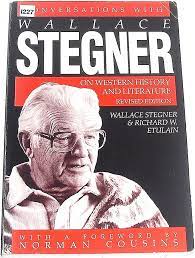Articles/Essays – Volume 18, No. 4
The Ultimate Stegner Interview | Wallace Stegner and Richard W. Etulain, Conversations with Wallace Stegner on Western History and Literature
With the possible exception of Louis L’Amour, Wallace Stegner has probably been interviewed more frequently than any other living Western writer. This is an impressive tribute to Stegner’s accessibility to representatives of both scholarly and popular publications, and to his seemingly perennial appeal to audiences at many levels. Even taken together, though, the Stegner interviews have not, until recently, given us a truly comprehensive view of the man, his ideas, and his literary craft. Richard Etulain’s cycle of ten interviews with Stegner—conceived, prepared, and edited with great skill—at last bridges those gaps.
The theme of the interviews is the complex mix of autobiography, history, and literature in Stegner’s work. Few of his books stand squarely in any of those categories alone, and anyone who would understand them must learn to work the literary trigonometry that Etulain carries off so expertly. Roughly half of the interviews are devoted to Stegner’s life and, chrono logically, each of his books, with one entire interview on his masterpiece, Angle of Repose. The remainder of the interviews deal with topics of especial significance in Stegner’s life and thought: the Mormons, the land, and other writers of Western fiction and history.
The interviews contain a few surprises. The ending to his prize-winning Angle of Repose, for example, eluded Stegner until a publisher’s deadline forced him to come up with something on very short notice. Mormon Country, he reveals, was primarily an exercise in nostalgia for a homesick Utah boy trapped in the East. These are amusing and unexpected disclosures for Stegner fans accustomed to appreciating his care and craftsmanship, but they show that Stegner even in offhand moments is still very good indeed.
Stegner is one of the rare non-Mormon writers who have written with sympathy, sensitivity, and perception about the Mor mons; and the Latter-day Saints have re paid him with their respect and loyalty. Curiously, Mormon readers have allowed him to make critical comments, both in Mormon Country and The Gathering of Zion, that few if any Mormon writers would have been permitted. Stegner admits to little interest in Mormon dogma, competence with Mormon doctrine, and even broad respect for Mormon culture and folkways. Evidently he assumes a corresponding selectivity in the way Mormon readers have approached his books, and he ascribes his popularity among them not primarily to what he says, but to the simple phenomenon of a local boy who makes good and thereafter can do no wrong at home. One observes that outsiders like Stegner are increasingly important as objective appraisals of Mormon culture by practicing Mormons are discouraged.
Stegner’s environmentalism, the subject of one entire interview, is heavily tinctured by his involvement with the Sierra Club, an involvement which, to those who cannot help regarding the typical Sierra Clubber as a bush-league outdoorsman, somewhat compromises his comments. Others will see them differently, and even hardened skeptics will acknowledge that Stegner has been, at times, a powerful advocate for preservation of the back country. To Stegner’s credit, he owns up to his occasional lapses, the most memorable being his collusion in the Sierra Club’s misbegotten bargain that sacrificed Glen Canyon to save Echo Park. He excuses himself, however, with a claim of astounding hubris: “Nobody knew Glen Canyon then except me; I’d been down it a couple of times” (p. 169). The names of a score or more of oldtime boatmen leap almost immediately to mind, many of whom had been through Glen Canyon more times than they could remember, and some of whom had taken tourists numbering literally in the thousands through Glen—tourists whose names bulge from visitors’ registers at popular locations all the way from Hite to the Crossing of the Fathers. They were, and still are, hopping mad about the Glen Can yon Dam, and they needed an articulate leader.
Those who have read Stegner extensively will find that these Conversations invariably enhance their appreciation of his mind and craft. For those who have read less of him, and for those few who have never read him at all, the interviews will still be meaningful in their disclosure of a thoughtful mind and a deeply humane temperament reflecting upon his career and materials. It is inevitable, though, that the greatest benefit the book will have for the latter class of readers will be to lead them into the Stegner novels, stories, and essays—a pleasure of discovery that old Stegner hands can only envy.
The University of Utah Press merits congratulation for handsome production at a reasonable price, and especially for Leo Holub’s fine candid photographs intespersed throughout the book. The photo graphs effectively convey the relaxed atmosphere in evidence throughout the text.
Conversations with Wallace Stegner on Western History and Literature by Wallace Stegner and Richard W. Etulain (Salt Lake City: University of Utah Press, 1983), 200 pp., $15.


 Back to full Issue
Back to full Issue

